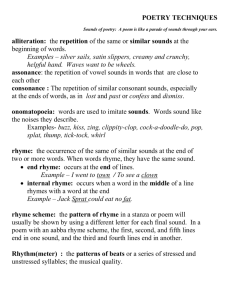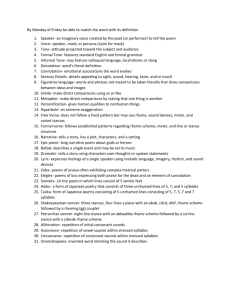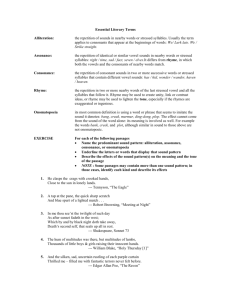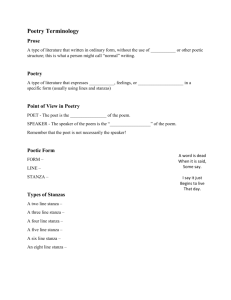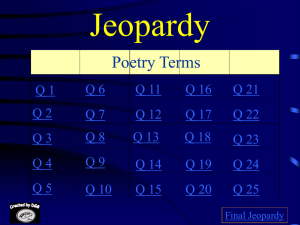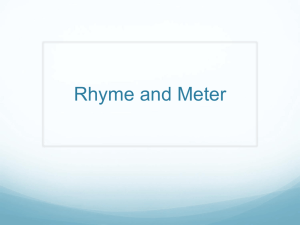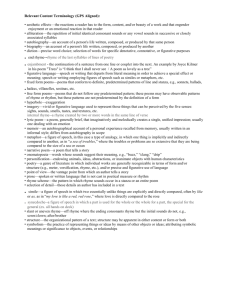Sound Poems Exercise
advertisement
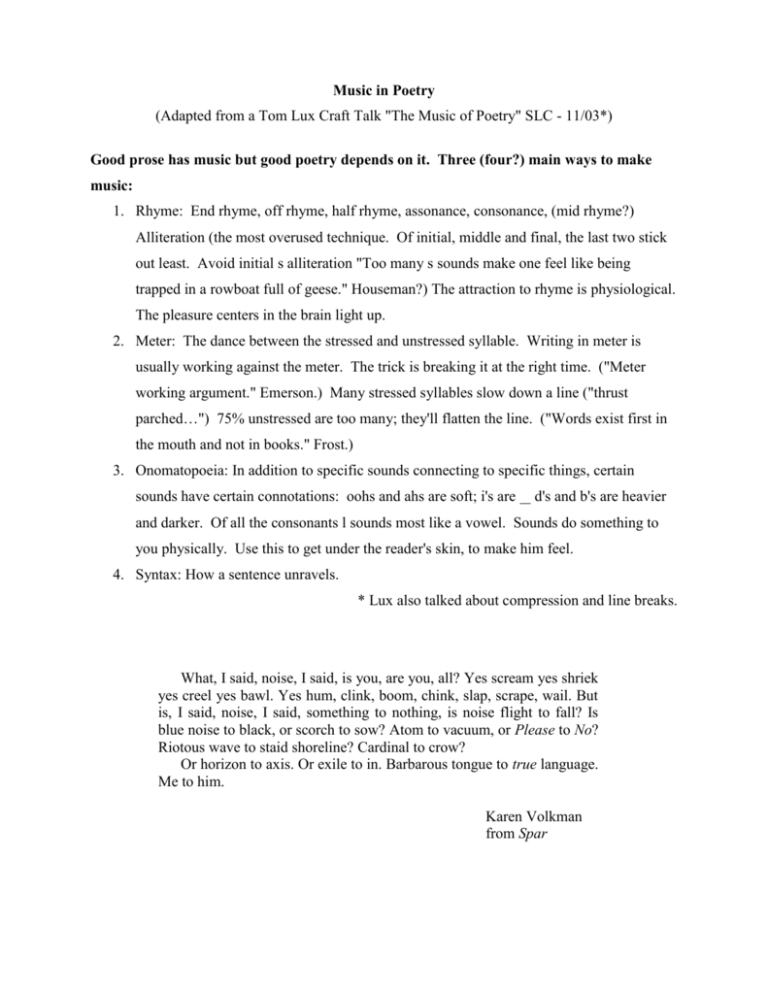
Music in Poetry (Adapted from a Tom Lux Craft Talk "The Music of Poetry" SLC - 11/03*) Good prose has music but good poetry depends on it. Three (four?) main ways to make music: 1. Rhyme: End rhyme, off rhyme, half rhyme, assonance, consonance, (mid rhyme?) Alliteration (the most overused technique. Of initial, middle and final, the last two stick out least. Avoid initial s alliteration "Too many s sounds make one feel like being trapped in a rowboat full of geese." Houseman?) The attraction to rhyme is physiological. The pleasure centers in the brain light up. 2. Meter: The dance between the stressed and unstressed syllable. Writing in meter is usually working against the meter. The trick is breaking it at the right time. ("Meter working argument." Emerson.) Many stressed syllables slow down a line ("thrust parched…") 75% unstressed are too many; they'll flatten the line. ("Words exist first in the mouth and not in books." Frost.) 3. Onomatopoeia: In addition to specific sounds connecting to specific things, certain sounds have certain connotations: oohs and ahs are soft; i's are d's and b's are heavier and darker. Of all the consonants l sounds most like a vowel. Sounds do something to you physically. Use this to get under the reader's skin, to make him feel. 4. Syntax: How a sentence unravels. * Lux also talked about compression and line breaks. What, I said, noise, I said, is you, are you, all? Yes scream yes shriek yes creel yes bawl. Yes hum, clink, boom, chink, slap, scrape, wail. But is, I said, noise, I said, something to nothing, is noise flight to fall? Is blue noise to black, or scorch to sow? Atom to vacuum, or Please to No? Riotous wave to staid shoreline? Cardinal to crow? Or horizon to axis. Or exile to in. Barbarous tongue to true language. Me to him. Karen Volkman from Spar Fruitless in Florida. Not Florence italicizing our differences. Pilfering our peachlessness, our plumless, pitless, pitilessness. Did you? No. Don’t you? Won’t you? But no. Orangeless Clementine! Tangerine dreamlessness. Nope cantalope. Nope cantaloping, leaping, gamboling, careening, no preening, no pruning in my arborless grotto. My trees are picked clean, gleaming air. Your orchards droop with dark weight of nothing. Can you? No. Can’t you? Tilt you? Are you? Know you? Rome steals from Athens and I steal from you. Steel you. Are you? But no, I’ve said that. JP – KV parody It’s algebra! Algorhymes and rhythms, sum for sun, windstrewn for windblown. A melody of non sense — No, sound-sense. A libation, liberation, yes, but with no real application? Just affectation, no implications? Oh no, sir. I beg you: one lake breeze; one late day sky; two thin grey cumuli = one heart; one lie. This calculus, calculi of sound over sense, heart - no, ear over whence we come to know. Either/or; less than/more than; metaphor. A train leaves Chicago at a constant rate of speed. Where will it intersect? Include your work. Cross your t’s. But. So. Why? You can’t begin to comprehend. Yet. There’s always a yet. JP – KV explanation? ELEGY FOR JANE My Student, Thrown by a Horse I remember the neckcurls, limp and damp as tendrils; And her quick look, a sidelong pickerel smile; And how, once startled into talk, the light syllables leaped for her, And she balanced in the delight of her thought, A wren, happy, tail into the wind, Her song trembling the twigs and small branches. The shade sang with her; The leaves, their whispers turned to kissing, And the mould sang in the bleached valleys under the rose. Oh, when she was sad, she cast herself down into such a pure depth, Even a father could not find her: The Life of an Ear Scraping her cheek against straw, Stirring the clearest water. Snap, Blap, Ring, Ting. Cha-Ching, Bling, Ding-a-ling. My sparrow, you are not here, Pow, Boom, Bam, Blam. Waiting like a fern, making a spiny shadow. Crack, Screech, Clang, Slam. The sides of wet stones cannot console me, Tic, Toc, Click, Clack, Nor the moss, wound with the last light. Smick, Smack, Patty-whack. TPit, Pat, Snip, Snap, If only I could nudge you from this sleep, Zing, Blip, Clip, ZZZap, My maimed darling, my skittery pigeon. Jingle, Dingle, Tingle, Tap. Over this damp grave I speak the words of my love: Gurgle, Glug, Gulp, Plop, I, with no rights in this matter, Doink, Sizzle, Zoom, Pop. Neither father nor lover. Theodore Roethke Shhh. Tom P Annotation of Sound in Elegy for Jane The poem starts with lots of m's (memories), limp and damp (the last two mp's)) and l's with curls and tendrils and the l from limp and even harking back to the l in Elegy of the title. The second line brings in k's with quick and look and the pick of pickerel and more l's from look and long and pickerel. The s's in sidelong and smile echo the s's in the first line (neckcurls and tendrils) and continue in the startled and syllables of line three. The l's continue with light, syllables and leaped and in the previous lines sidelong, pickerel and smile and buried more deeply in startled and talk. These light and lively sounds fit the memories of Jane alive and happy. The long lines leave plenty of room for the soundplay. All this music sounds like overkill in an annotation but is more subtle in the reading. Still I'm happy to find a b in line four (balanced) that has no echo until line six (branches). The l's continue in balanced, delight, tail, trembling and small. Some w's (wren and wind (and buried in twigs), some t's (initial t's in tail, trembling and twigs and ending t's in delight and thought), some n's in wren, in and wind vary the music, but the s's take over (song, twigs, branches, shade and sang side-by-side, leaves, whispers, kissing, sang, valleys, and rose). Maybe mold is there to echo the o in rose. Which reminds me that I've been ignoring the vowels. Let's go back. The short e's bounce from mem to ten in memories and tendrils with a short hop at neck. We've got short i's in quick and pick(erel) and long i's in side and smile and light in line 3 and delight in line 4. Then short i's again in into and wind. All this bouncing back and forth makes me dizzy except that the long lines seem to settle the pace. The whole stanza is two sentences held tight by commas and tighter by semi-colons giving an expansiveness to all the music. The long o of Oh slows the pace (plus it's at the beginning of a new stanza) and leads a long line of s's (she, was sad, she, cast, herself and such) followed by three short lines with quick echoing consonants (father and find; against, straw, stirring and clearest) within lines and across lines (could and clearest; scraping and stirring). The lines of the stanza end with a comma, a colon, a semi-colon and a period showing Roethke using his full allotment of punctuation marks to control the rhythm beneath the music. Stanza 3 continues the shorter lines with caesuras to shorten the rhythm further (my sparrow, you are not here,/Waiting like a fern, making a spiny shadow.) It seems like the punctuation sets a rhythm for the melody of sounds to play over. The short words in the first line (you are not here) are a slow plaintive cry. The w's slide down from waiting to wet to wound (even echoed in the end-word w's of sparrow and shadow). And the s's carry throughout (sparrow, spiny, shadow, sides, stones, console, moss, last) until brought to an end with the t's of last and light. (Why do those two l's sound so sad here when the l's seemed so lively in the first stanza?) The short words and iambic rhythm of the opening line of stanza 4 slow the music. The m's (my maimed, my) a's (maimed and darling) and short i's (skittery pigeon) keep this second line tight. (I don’t know what a skittery pigeon is but I love the sound of it.) Damp harkens back to maimed and even back to limp and damp in the first line. This long line sets up the short and shorter lines that end the poem. Lots of I's and my's. And the final line, one of the shortest in the poem, may be the tightest. With the n's (neither, nor), the th's (neither and father), the er's (Neither, father, lover), the f/v's (father and lover), the short o's (nor and lover) almost all of the sounds are talking to each other in seven concise syllables. The shortness and tightness of the line combine with the content to bring the poem to a satisfying close. I feel like I faked this entire annotation, mimicking lines from Tom Lux or Stephen Dobyns until the entire house of cards collapsed into pile of scattered letters. (Have you ever read that children's story Chicka Boom Boom? This annotation has the same ending.) Did I fool you at all?
